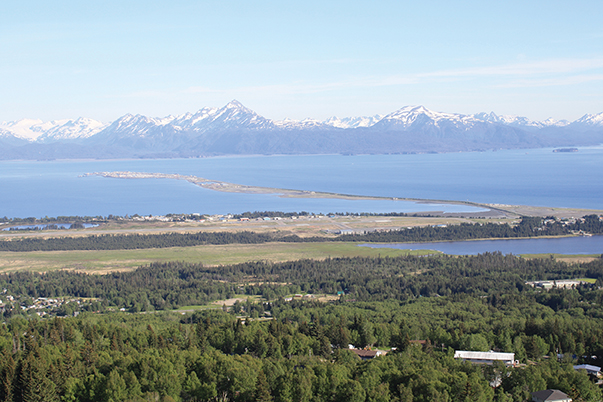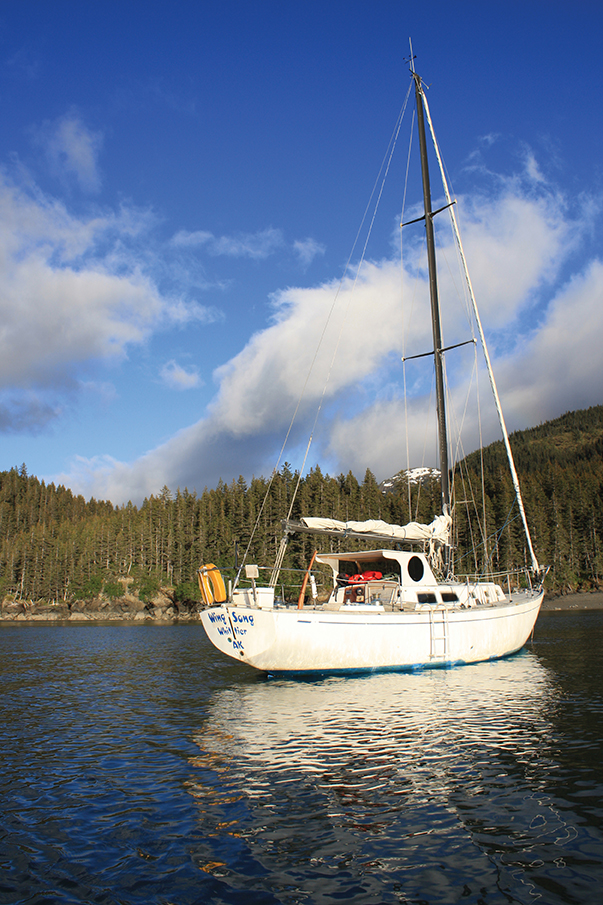Exploring the wonders of beautiful Kachemak Bay (published November 2013)
Anchored in Halibut Cove in Alaska’s Kachemak Bay State Park, my boyfriend, Arun Jain, and I watched the sun set around 11:30 p.m., signaling the start of the long, pink and blue twilight of an Alaskan summer night. A pale half-moon rose over the nearby snow-striped mountains as we enjoyed a late-night dinner of smoked halibut dip, crackers and gooseberry wine. It was a peaceful and auspicious beginning to our four-day exploration of Kachemak Bay on his Cal 36, Wing Song.
Arun and I provisioned for our adventure in Homer, Alaska, a port town along a spit where his boat is harbored year-round. We bought a growler of dark, chocolaty oatmeal stout called Odyssey at the Homer Brewing Company, and at the Bear Creek Winery we procured gooseberry wine and red zinfandel. During a wine tasting, the winery served us a delicious smoked halibut dip, so we picked up the recipe for that as well. It would be a great way to use the smoked halibut we’d gotten at The Auction Block Co., where we’d also stocked up on kippered Cajun salmon, smoked salmon strips and halibut fillets.
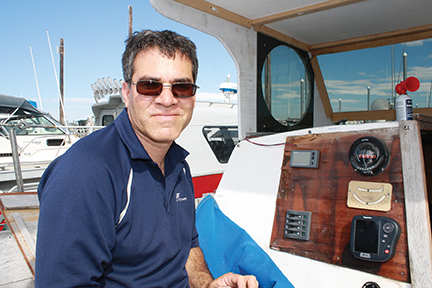
Before getting underway, Arun gave me a quick boat briefing, introducing me to Wing Song and her particular quirks. She’s a stout, seaworthy vessel that Arun has sailed in and around much of south central Alaska. As a vintage boat, built in 1966, she’s a work-in-progress and Arun has replaced many of her systems and is perennially renovating her interior. She’s a boat with soul and spirit—a perfect vessel for our explorations.
We set off from Homer around 6:45 p.m. on a warm, sunny Tuesday afternoon—near perfect conditions in an area known for its steady summer rainfall. We motored out of Homer’s harbor and into the broad, blue bay. With northeast winds around 11 knots, we let out some of the jib and about one-third of the way across we hoisted the mainsail. The wind carried us gently across the bay at around four knots and as we entered Halibut Cove we took the sails down and fired up the engine. We motored around, looking at the spruce-lined banks and avoiding buoys marking oyster farms, and eventually anchored in 55 feet of water near the trailhead for the Saddle Trail, which would be the start of our hike up to Grewingk Glacier the next day.
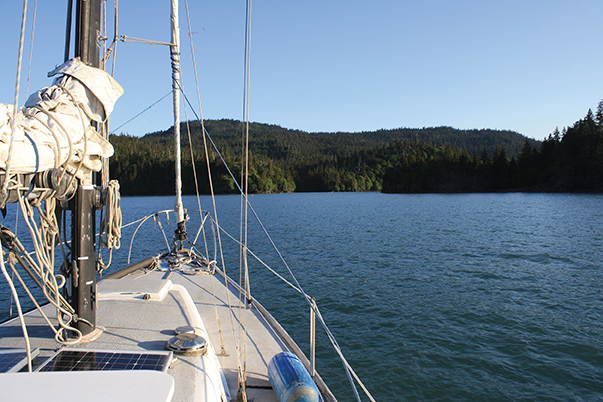
After dinner, as Wing Song drifted lazily around her anchor, we watched wispy clouds above the cove turn orange and pink. A water taxi motored by to pick up several sea kayaks, tall spruce trees rose up on the mountains all around us, and snow zebra-striped the high green mountains behind. Later, as we lay in the V-berth, the wind came up and lapped against the hull, gently rocking us to sleep.
The next morning dawned rainy and cool. We had raspberries, yogurt and French-pressed coffee while listening to the rain drizzle on the boat’s cabin. Our plan was to raft down the creek from the glacier so we packed up our packrafts, paddles, lifejackets, snacks and water. We rowed the dinghy over to shore through the drizzle, pulling up on the rocks. From there we climbed the steep, slippery trails up to the beginning of the Saddle Trail, and then through the spruce forest over to a glacial valley filled with willows and alders. We took a hand tram over Grewingk Creek, pulling ourselves across with the rope, and scoped out the rushing, gray silty waters of the creek before getting back on the trail. At every turn we had expansive views of the blue ice glacier in the distance, surrounded by green and snowy mountains. The closer to the glacier we got, the more bear scat we saw, some of it fresh and alarmingly large, so we made lots of noise and Arun held on tight to his bear spray. We finally climbed the final ridge that looked out over the glacier and stood there a while in the cold wind, admiring the broad expanse of blue ice with its deep crevasses.
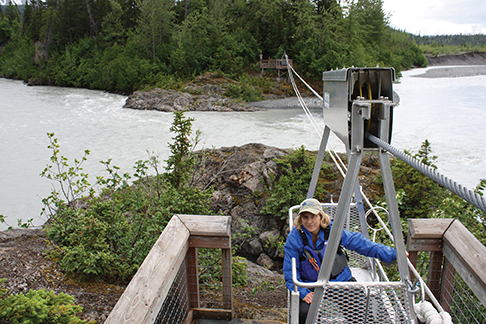
On the way back we talked about our plans to raft the swiftly-moving creek, but it was getting late and we were both tired, so we decided it might be better to use the rafts just to cross the creek and cut back to the Saddle Trail. We inflated the rafts, donned our dry suits and ferried across the fast-moving water. It seemed like a lot of work just for a creek crossing, but saving a few miles walking at that point seemed well worth it.
We finally made it back to shore around 11 p.m., exhausted. After getting back to the boat we put on dry clothes and feasted on smoked salmon, smoked halibut, cheese, crackers, grapes and oranges before collapsing in the V-berth and falling into a deep sleep.
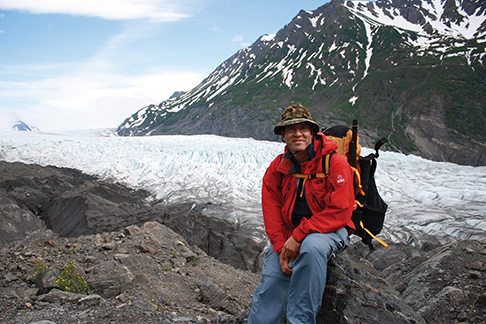
The next day was partly sunny and cool, in the 50s, with southwest winds around six knots. After a leisurely breakfast, we raised anchor around noon and motored out of Halibut Cove and into the bay. Our next stop was Tutka Bay, a few bays down from Halibut Cove. Around 2 p.m. we put up the mainsail and tacked against the 10-knot wind for a while before setting the jib and sailing toward Tutka Bay at about five knots, passing bird-covered Gull Island and Yukon Island.
Tutka Bay is beautiful and more remote than Halibut Cove. We found a spot near where a trail took off up to Tutka Lake and anchored in 60 feet of water, though by the morning we’d measured a depth of almost 80 at high tide. That night, we made lentil curry with Arun’s pressure cooker, along with tortilla shells cooked with garlic and salt for a kind of naan. After dinner we took the dinghy to shore and hiked up through a green, lush, spruce and blueberry forest to Tutka Lake. By the time we returned to the shore a few hours later the sun was just setting and the orange light in the sky was reflecting on the waters of the bay. Arun rowed the dinghy past rocky cliffs to Wing Song, and as we boarded the boat, jellyfish swam gracefully around the hull.
The next day, we ate breakfast around 9 a.m., pulled up the anchor, and put up the jib to sail out of Tutka Bay and into Kachemak Bay where the wind was blowing from the southeast. We kept the jib out and sailed down to Seldovia, just outside of the state park’s boundary. About halfway there, we decided to do some motorsailing and tried to crank up the engine, but it wouldn’t start. Arun worked on it for a while and I held our position. We talked about sailing back to Homer and calling for a tow, but eventually, after he fiddled with various cables and connections, it started. Off again, we motorsailed until we got near Seldovia, then put away the sails and motored into the harbor’s narrow channel.
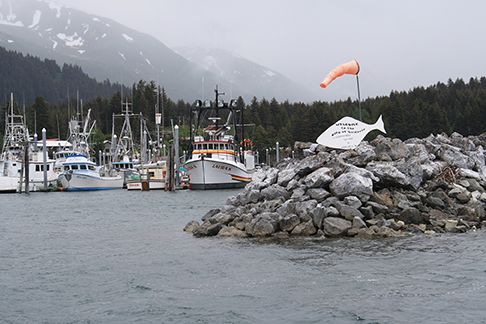
In an area inhabited by native tribes for centuries, Russian herring fishermen and trappers founded the quaint and quirky town of Seldovia in the 19th century. We radioed in and the harbormaster told us we could tie up for the day to the harbor’s B float at no charge. It was a cool, drizzly day and we walked into the town’s main district along the waterfront and stopped for lunch at the Tidepool Café. After lunch we walked around town, looked at the Russian Orthodox Church at the top of the hill and meandered along the boardwalk by the town’s slough.
Late that afternoon we headed back to Homer, passing a sea otter rolling and smiling at us near the entrance to the town’s harbor. The sun shone brightly as we motorsailed back watching the mountains and bays we’d explored over the last several days stream past, before finally seeing Homer come into view across the sparkling waves.
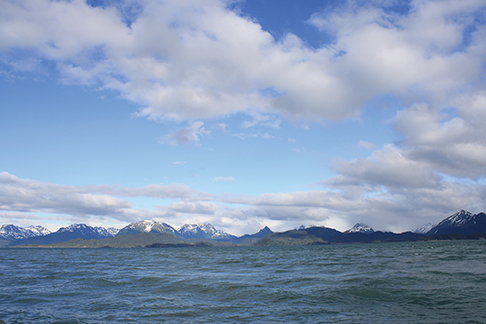
Homer, Alaska will be your starting point for exploring Kachemak Bay. It has a population of around 5,000 with numerous stores and amenities to help get you ready. For more information about its harbor, which is situated on the Homer Spit, visit www.cityofhomer-ak.gov/port.
When she’s not sailing in Alaska, Vivian Wagner lives in New Concord, Ohio, where she teaches journalism at Muskingum University. Her work has appeared in many publications, and she is the author of Fiddle: One Woman, Four Strings, and 8,000 Miles of Music. For more information about her and links to her work, visit her website at www.vivianwagner.net.
Kachemak Bay State Park
Kachemak Bay State Park was established in 1970 as Alaska’s first state park. Accessible only by water or air, the park and its wilderness area together comprise 400,000 mountainous acres. The prime sailing months are May through September, though some hardcore sailors head out on the occasional sunny winter day. Homer, just a few nautical miles across the bay from the park, is the nearest point accessible by road. Though some maps and charts show public mooring buoys in several of the state park’s coves and bays, these aren’t always available or existent, so it’s best to plan to anchor. With over 25 miles of trails, as well as peaks, rivers, creeks, lakes and glaciers, the park also provides lots to do on land. For more information visit http://dnr.alaska.gov/parks/units/kbay/kbayl.htm.
Homer Brewing Company
1411 Lake Shore Dr. Homer, AK 99603
907-235-3626
Open Mon.-Sat. noon-7 p.m., Sun., noon-6 p.m.
www.homerbrew.com
Bear Creek Winery
60203 Bear Creek Drive, Homer, AK 99603
907-235-8484
Open May-Sept., 10 a.m. – 6 p.m. daily
Oct.-April, Mon.-Sat., noon-6 p.m., Sun., noon-4 p.m.
www.bearcreekwinery.com
The Auction Block Co.
4501 Ice Dock Rd.
Homer, AK 99603
907-235-7267
Open May-Sept., Mon.-Sat., noon-6 p.m.
www.alaskashealthyseafood.com
Tidepool Café
257 Main St, Seldovia, AK 99663
907-234-7502
Open Sun.-Thurs., 7 a.m.-4 p.m., Fri.-Sat, 7 a.m.-8 p.m.
Boat Charters
If you don’t have your own boat, but want to sail the waters of Kachemak Bay, you might consider chartering a boat. Options include Homer Boat Rentals (www.homerboatrentals.com) and Sail Homer (www.sailhomer.com).
Homer Yacht Club
To connect with other sailors in the area, participate in a regatta, or just get some advice from locals, check out the Homer Yacht Club (www.homeryachtclub.org).
